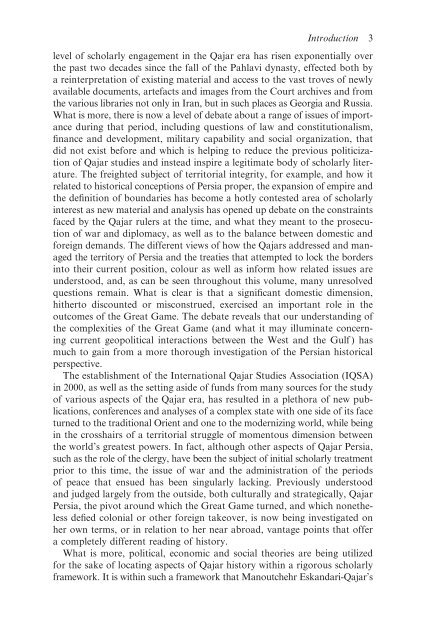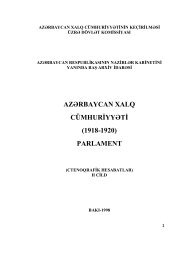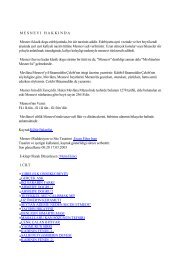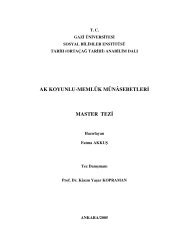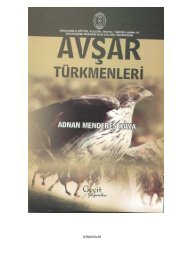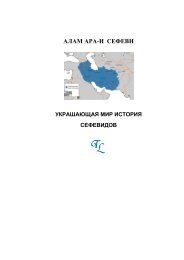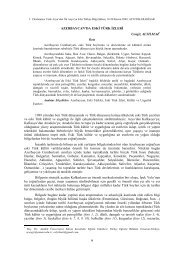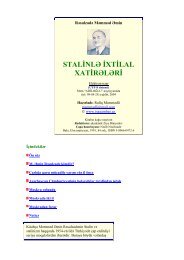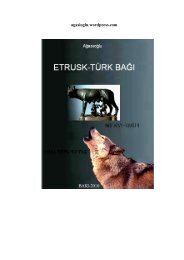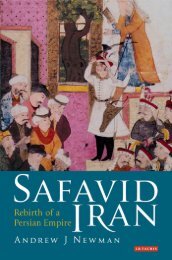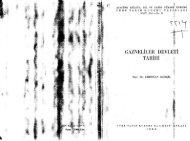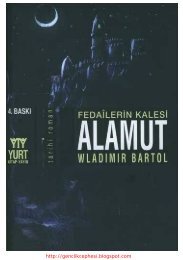War and Peace in Qajar Persia: Implications Past and ... - Oguzlar.az
War and Peace in Qajar Persia: Implications Past and ... - Oguzlar.az
War and Peace in Qajar Persia: Implications Past and ... - Oguzlar.az
- No tags were found...
You also want an ePaper? Increase the reach of your titles
YUMPU automatically turns print PDFs into web optimized ePapers that Google loves.
Introduction 3level of scholarly engagement <strong>in</strong> the <strong>Qajar</strong> era has risen exponentially overthe past two decades s<strong>in</strong>ce the fall of the Pahlavi dynasty, effected both bya re<strong>in</strong>terpretation of exist<strong>in</strong>g material <strong>and</strong> access to the vast troves of newlyavailable documents, artefacts <strong>and</strong> images from the Court archives <strong>and</strong> fromthe various libraries not only <strong>in</strong> Iran, but <strong>in</strong> such places as Georgia <strong>and</strong> Russia.What is more, there is now a level of debate about a range of issues of importancedur<strong>in</strong>g that period, <strong>in</strong>clud<strong>in</strong>g questions of law <strong>and</strong> constitutionalism,f<strong>in</strong>ance <strong>and</strong> development, military capability <strong>and</strong> social organization, thatdid not exist before <strong>and</strong> which is help<strong>in</strong>g to reduce the previous politicizationof <strong>Qajar</strong> studies <strong>and</strong> <strong>in</strong>stead <strong>in</strong>spire a legitimate body of scholarly literature.The freighted subject of territorial <strong>in</strong>tegrity, for example, <strong>and</strong> how itrelated to historical conceptions of <strong>Persia</strong> proper, the expansion of empire <strong>and</strong>the def<strong>in</strong>ition of boundaries has become a hotly contested area of scholarly<strong>in</strong>terest as new material <strong>and</strong> analysis has opened up debate on the constra<strong>in</strong>tsfaced by the <strong>Qajar</strong> rulers at the time, <strong>and</strong> what they meant to the prosecutionof war <strong>and</strong> diplomacy, as well as to the balance between domestic <strong>and</strong>foreign dem<strong>and</strong>s. The different views of how the <strong>Qajar</strong>s addressed <strong>and</strong> managedthe territory of <strong>Persia</strong> <strong>and</strong> the treaties that attempted to lock the borders<strong>in</strong>to their current position, colour as well as <strong>in</strong>form how related issues areunderstood, <strong>and</strong>, as can be seen throughout this volume, many unresolvedquestions rema<strong>in</strong>. What is clear is that a significant domestic dimension,hitherto discounted or misconstrued, exercised an important role <strong>in</strong> theoutcomes of the Great Game. The debate reveals that our underst<strong>and</strong><strong>in</strong>g ofthe complexities of the Great Game (<strong>and</strong> what it may illum<strong>in</strong>ate concern<strong>in</strong>gcurrent geopolitical <strong>in</strong>teractions between the West <strong>and</strong> the Gulf ) hasmuch to ga<strong>in</strong> from a more thorough <strong>in</strong>vestigation of the <strong>Persia</strong>n historicalperspective.The establishment of the International <strong>Qajar</strong> Studies Association (IQSA)<strong>in</strong> 2000, as well as the sett<strong>in</strong>g aside of funds from many sources for the studyof various aspects of the <strong>Qajar</strong> era, has resulted <strong>in</strong> a plethora of new publications,conferences <strong>and</strong> analyses of a complex state with one side of its faceturned to the traditional Orient <strong>and</strong> one to the moderniz<strong>in</strong>g world, while be<strong>in</strong>g<strong>in</strong> the crosshairs of a territorial struggle of momentous dimension betweenthe world’s greatest powers. In fact, although other aspects of <strong>Qajar</strong> <strong>Persia</strong>,such as the role of the clergy, have been the subject of <strong>in</strong>itial scholarly treatmentprior to this time, the issue of war <strong>and</strong> the adm<strong>in</strong>istration of the periodsof peace that ensued has been s<strong>in</strong>gularly lack<strong>in</strong>g. Previously understood<strong>and</strong> judged largely from the outside, both culturally <strong>and</strong> strategically, <strong>Qajar</strong><strong>Persia</strong>, the pivot around which the Great Game turned, <strong>and</strong> which nonethelessdefied colonial or other foreign takeover, is now be<strong>in</strong>g <strong>in</strong>vestigated onher own terms, or <strong>in</strong> relation to her near abroad, vantage po<strong>in</strong>ts that offera completely different read<strong>in</strong>g of history.What is more, political, economic <strong>and</strong> social theories are be<strong>in</strong>g utilizedfor the sake of locat<strong>in</strong>g aspects of <strong>Qajar</strong> history with<strong>in</strong> a rigorous scholarlyframework. It is with<strong>in</strong> such a framework that Manoutchehr Esk<strong>and</strong>ari-<strong>Qajar</strong>’s


